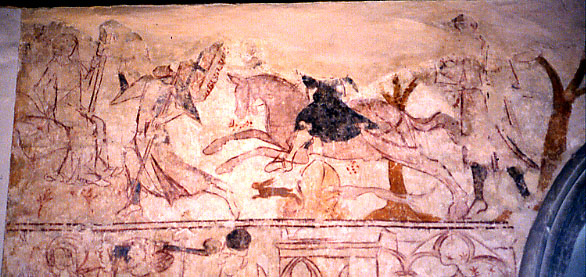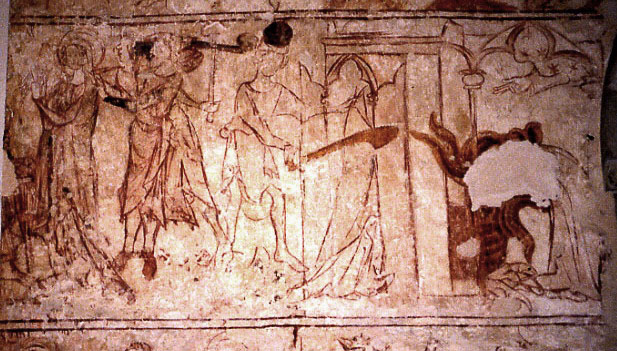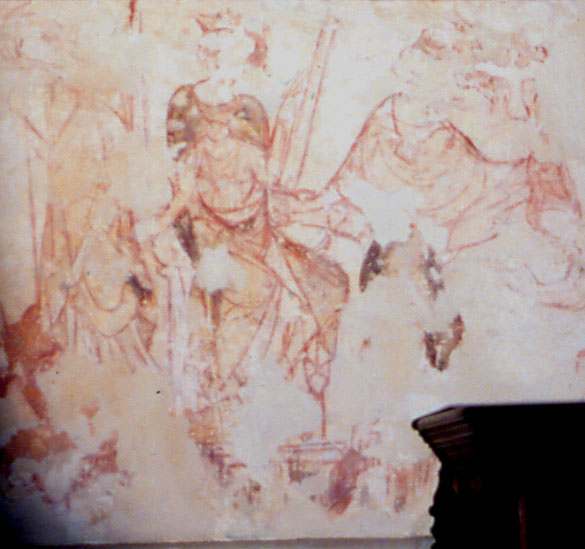Charlwood, Surrey (†Southwark) c.1320
Life of St Margaret

The painting is in vertically arranged tiers, and at the top left, Margaret is shown spinning with a distaff, while a man with a banner (a cross on a field fretty) kneels before her. This man must be the herald of the Antioch governor Olybrius, who is the man on a fast galloping horse in the centre of the scene. Like any English medieval king or magnate, Olybrius is out hunting, and his greyhound, a pale shape in front of the tree (pink seems to have been the original colour), pursuing a fleeing hare, is said in the leaflet available in the church to be the earliest depiction of the breed in Britain¹. At the far right, a huntsman is blowing his horn.

In the central tier, part of the painting – it is uncertain how much – is missing at the left-hand side, but at the left now (detail, left) Margaret stands with both hands upraised in a standard attitude suggesting in this case remonstrance, probably with Olybrius, who is in all likelihood the figure implied by a chairleg and part of a seat at the left-hand edge. Further right, Margaret is arrested, beaten with clubs, and then pushed through a Gothic-arched doorway into prison by a jailer with another club (centre of picture). Finally, at the right, the bending figure of Margaret is seen disappearing into the mouth of a red dragon with huge scaly claws. It is a great pity that so much of this dragon – an unusual example – has been damaged. But a hand and arm – a version of the Manus Dei – reaches out from a star-studded heaven at the top right in a gesture of blessing.
![Life of St Margaret, Charlwood, detail [40KB]](images/charlsm2.jpg)
In the lowest panel (shown right) the story continues. At the left, Margaret is shown, quite upright and possibly with her hands clasped in prayer, emerging directly from the dragon’s belly. The creature’s backbone seems to have burst asunder in the process – at least this seems to be the meaning of the detail to the right, where something like a chain of articulated vertebrae loops down between the legs of the man arresting Margaret for the second time.
After her miraculous escape from the dragon, Margaret suffered various tortures, some of them painted in the English church, as at Battle in Sussex, where she is shown hung up by her hair and beaten. Charlwood’s version of the story is more selective, and at the right in this tier (above, right of picture) she is shown standing, and although it is very difficult to see now, thrusting the end of her cross-staff into the mouth of the dragon, on whose defeated head she now stands. She holds something else in her left hand, but I cannot identify this.

Beyond Margaret at the right, a crowned figure seated on a throne seals her fate (detail, left). This figure, in the center of the scene, is probably not the governor Olybrius, whose rank would not seem to merit a crown², and it may be intended for the Emperor Diocletian, in whose reign, according to her Legend, Margaret and those she converted were beheaded. Or this may be simply a generic authority-figure.
At any rate, at the far right, an executioner raises his sword to decapitate Margaret, who is just visible at the right hand edge, kneeling with hands held in prayer as the executioner grasps her by the hair. Above her, her soul is shown in the form of a white dove flying up to heaven.
The painting has a complicated restoration history and various published articles from the late 19th and early 20th centuries tend to confuse rather than clarify understanding. Apart from some later cleaning and retouching it was restored to its present state by Eve Baker in the 1960s³. Similarities to the paintings of the same subject in the Queen Mary Psalter (BM. MSt Royal 23, vii) have been remarked on in several of the early articles mentioned above. The painting is certainly of very high quality, as is the less well-preserved Three Living & Three Dead, beside it on the south wall at Charlwood.
Another, less well preserved Life of St Margaret, at Wendens Ambo in Essex is now on the site. It is in some ways very similar to the Charlwood example, but there are some vital differences as well. The same is true of the example of her martyrdom at Duxford, long mistaken for a painting of St Agatha, which is newly on the site and linked in the table below.
Website for St Nicholas, Charlwood
¹ I cannot find a source for this claim. It may be true, nevertheless.
² Although he evidently had one, not visible now, at Wendens Ambo
³ T. Organ, St Nicholas Church, Charlwood, Surrey. Report on the cleaning and conservation of the 14th & 15th century mural paintings in the nave carried out in June 1993, The Wall Paintings Workshop, Faversham, Kent.